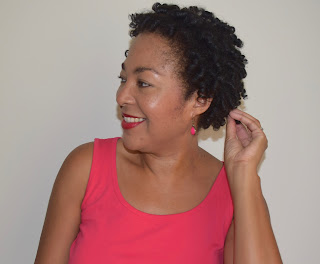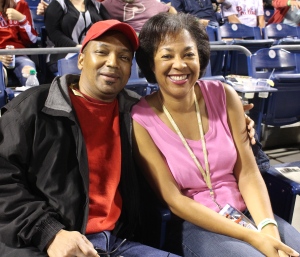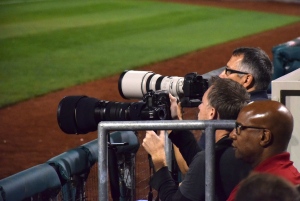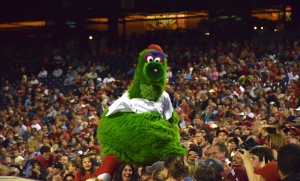“I praise you because
I am fearfully and wonderfully made; your works are wonderful, I know that full
well.” (Psalm 139:14)
In November 2013, I took a brave step to stop getting
relaxers in my hair. It was a tough and scary decision, because I had become a
slave to relaxers due to the false belief that my hair texture was
unacceptable; that it was considered “bad” or “nappy” and that I had to
straighten it with either a hot comb or a relaxer to be accepted in society.
But after 35 years of relaxers—yeah 35 years—my hair was in desperate need of
repair. It was constantly breaking and noticeably thinning.
Good Hair vs Bad Hair
As many African American women age 50 and older can attest,
the message that our natural hair texture was unacceptable began when we were
little girls. We were told that we either had “good” hair or “bad” hair. If our
hair was course, rough to the touch, and hard to comb, it was considered “nappy”
or “peasy,” and we had “bad” hair. If our hair texture was soft and manageable,
even silky, we had “good” hair. And many of us were jealous of our African
American sisters if their hair wasn’t “nappy,” but thick and wavy, and long.
My mom didn’t know how to take care of my hair. It was
extraordinarily course, and “unmanageable” so-called. Whenever she tried to do
my hair, I cried and cried. When she couldn’t take it anymore, she brought me
to the hairdresser with her every two weeks. And at the tender age of 8 I was
introduced to the dreaded and painful hot comb.
Hot Comb Trauma
The hot combs of old were heated over flames on mini stoves
so the hairdresser couldn’t control how hot they were before running them
through your hair. Billows of smoke would flow from the comb if the hairdresser
left it on the burner too long. My eyes would widen and my body would freeze in
the chair praying she wouldn’t burn me. She’d cool off the comb by banging it on
a white-turned-brown towel before raking it through my hair. My hair would be
weighed down with a ton of grease to protect my hair from the intense heat, and
she’d press out every kink she could find as my hair sizzled. Often, the hot
comb burned the tips of my ears, the nape of my neck, and the edges of my
hairline, and I’d leave the salon in tears wanting never to return. But it
would be another five long years before my mom allowed me to say goodbye to the
dreaded hot comb and hello to my first relaxer.
Relaxer Heaven
At age 14, my mom gave me permission to get a relaxer, and I
never looked back. From that point on, I swore I’d never go back to the hot
comb again. And for the next 35 years I’d get relaxers every 6 weeks, then
eventually every 8 weeks, then every 12 weeks as time marched on. But in the
end, much to my chagrin, the relaxers took their toll. They weakened my hair,
damaged some hair follicles, and forced me to bid them farewell.
I was so sad and apprehensive. It had been 30+ years since I
saw or even dealt with my natural hair. How would I take care of it? How would
I wear it? What was I going to do? I never thought I would have to stop getting
relaxers. I figured I’d get them until the day I died.
Natural Hair Journey
To grow out my relaxer, I went to the hairdresser every two
weeks to have my hair washed, conditioned, blow dried, flat ironed, and curled.
I wasn’t about to do my own hair. In fact, because my hair was flat ironed, it looked
like it was relaxed and I was fine with that. At least I was no longer putting
that chemical in my hair.
 In the meantime, I discovered an incredible online community
of young African American women who grew out their relaxers, were
transitioning, or had always been natural. They represented what is called The Natural Hair Revolution. Many of these
incredible, beautiful women have YouTube Channels where they regularly post
hair care tutorials. They teach you how to wash, condition, and style natural
hair. They do product reviews and demonstrate hairstyling techniques to get
awesome results for rod sets, twist outs, bantu knots, curly fros, and wash ’n
Gos. They even teach you how to accessorize your fro with pretty scarves and
stylish head bands. These women are super talented, super creative, and
inspirational. My favorite natural hair care vloggers who have YouTube channels are SimplyCin, NaturalMe4c, and Naptural85. I also discovered a natural hair care website called
Naturallycurly.com that provides articles, videos, and product reviews on everything
you need to know about natural hair care.
In the meantime, I discovered an incredible online community
of young African American women who grew out their relaxers, were
transitioning, or had always been natural. They represented what is called The Natural Hair Revolution. Many of these
incredible, beautiful women have YouTube Channels where they regularly post
hair care tutorials. They teach you how to wash, condition, and style natural
hair. They do product reviews and demonstrate hairstyling techniques to get
awesome results for rod sets, twist outs, bantu knots, curly fros, and wash ’n
Gos. They even teach you how to accessorize your fro with pretty scarves and
stylish head bands. These women are super talented, super creative, and
inspirational. My favorite natural hair care vloggers who have YouTube channels are SimplyCin, NaturalMe4c, and Naptural85. I also discovered a natural hair care website called
Naturallycurly.com that provides articles, videos, and product reviews on everything
you need to know about natural hair care.
After reading several articles and watching these videos on
YouTube for almost two years, and admiring these and other black women from
afar who wear natural styles, I finally took the plunge—I decided to stop blow
drying and flat ironing my hair and truly embrace my natural hair.
Joining the
Revolution
I got my first rod set in mid-July and have been getting
them ever since. My hairdresser did my first three rod sets. And I did the last
two (see photos) all by myself. I learned what products I needed to buy and how
to put the rods in from watching my YouTube gals, and much to my surprise my
hair came out really nice. Next, I’m going to try a twist out.
I have to admit that caring for my natural hair requires an investment
of time and some extra money. The products are pricey and the amount of time it
takes to do my hair on washday is daunting. But I’m a novice at this, and I’m
sure I’ll be able to reduce the time it takes once I become more experienced. The
good news is that after you do your hair on washday, all you have to do is
cover it at night with a satin bonnet and go to sleep.
Feeling Free
Nonetheless, the hardest part for me is over. I’m no longer
a slave to relaxers; I’m no longer afraid to wear my hair in its natural state nor
worried about whether the world will accept me. I feel a sense of freedom and
peace. Free to wear and accept the hair God has given me. Free to be me!


















